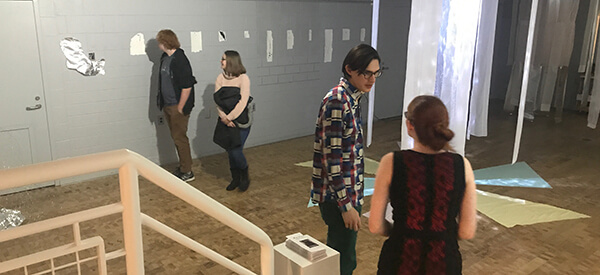Harbor: The exchange where everything transforms

Six art students from School of Art Professor Mille Guldbeck’s Senior Studio course found harbor in a recent exhibition in the Fine Arts Center.
Their show, “Harbor: Material Thinking,” was installed at the end of fall 2018 in the woodshop-turned The Red Door Gallery. According to School Director Charles Kanwischer, “It was a cool show and a good example of the new student-centered, student-programmed gallery.”
The students who collaborated on the project included seniors Truman Chambers, Trevor Goebel, Lauren Holcomb, Christin Kern, Leeann Ream and Michelle Whitmer.
In addition to being a project for the course, the group also received a Center for Undergraduate Research and Scholarship (CURS) grant to explore research in the art dimension.
The exhibition title came from the readings they examined and discussions they had in, and out of, Guldbeck’s class. Text from Paul Carter’s “Interest: The Ethics of Invention,” prompted them to interpret the notion of a harbor, the CURS grant proposal stated.
“As practitioners of drawing and painting within the final year of our studies, we argue that creative arts research is often motivated by personal and emotional concerns. It does not function on the basis of exact knowledge, but rather relies on embracing tacit knowledge.
“It is in the joining of the hand, the eye and the mind that we can start to understand a material knowledge. Through written language, we may be able to communicate certain ideas, but through material process we establish a logic of practice that becomes crucial to our future development as artists.”
The idea of “harbor” resonated with them, Kern explained. “A harbor is the site of exchange, occurring wherever a place of meeting produces change. Over time, this harbor and everything within it will transform through this exchange—whether it be a transfer of goods or the communication of ideas.”
Chambers added, “Harbor was an opportunity for all involved to operate in modes of expression we don’t often find time for otherwise.” The painting and drawing major veered away from his standard, and instead, created an audio installation subtitled “In Between.”
“Writing, recording and producing music has been an interest of mine for a few years, but I don’t generally have much time to invest in it during school. He explored audio in a more deliberate and focused manner and was able to relate the music he created to his study of visual art.
For Ream, who specializes in observational figurative drawing, developing the exhibition “provided a unique experience for me to collaborate with my peers in a completely new way.
“I found myself conducting short interviews, shadowing their process, maintaining strong lines of communication, and participating in arts-related writing. These exercises veer more toward arts administration than studio art practice itself, and I have found that I am fervently passionate about both.”
“When we began our work, we each had specific ideas as to how the project would turn out.” Kern said. But she, like the others, discovered that the final installation was quite different from the initial plans. Within the site of this creative exchange came a magnificent transformation.
“The planning fell through because there was no telling what would work until I had tried it,” she added. By the time their pieces were completed, the installation had “taken on a form that was entirely different.”
They found that in order for their work to grow and progress they had to learn to accept the change.
The exhibition comprised the installations “In Between,” audio, and “Both-and Gestures, ink on paper, both by Chambers; “Weave,” cloud forms installation by Holcomb; “Interim,” video by Whitmer; “Fragments of Familiarity,” fabric installation by Kern; and “Land,” photography by Goebel.
Updated: 01/05/2022 01:39PM
